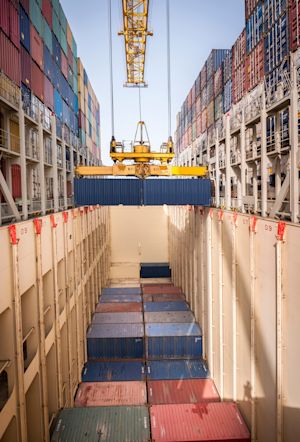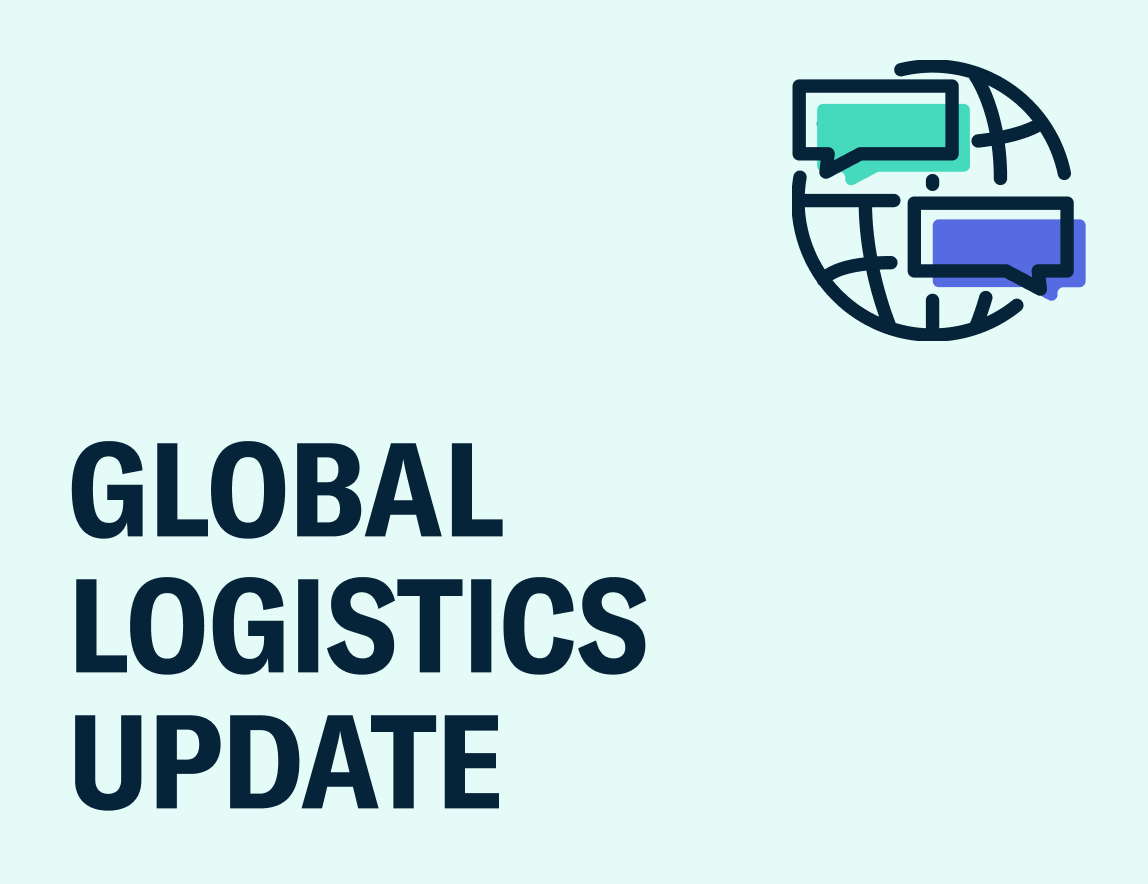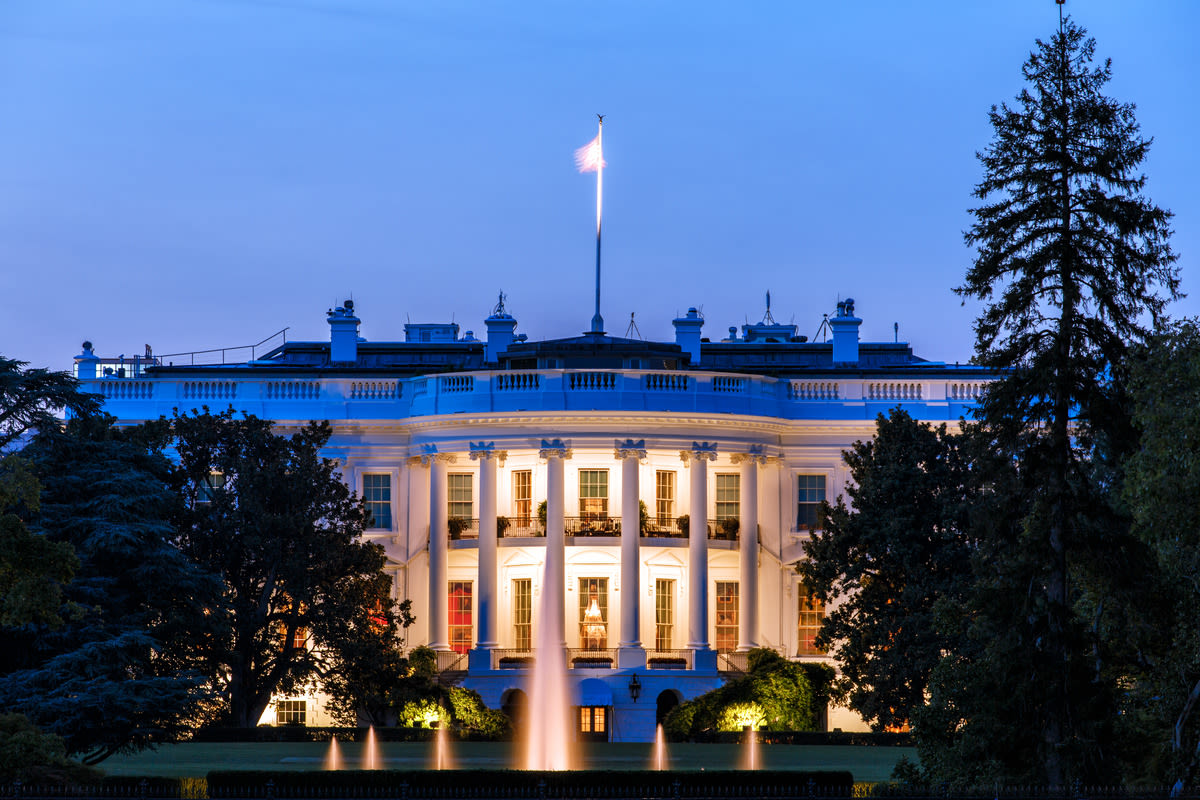
Global Logistics Update
Tariff Collection Continues Amid Government Shutdown; Ex-Asia Air Freight Sees Demand Surge
Updates from the global supply chain and logistics world | October 2, 2025
Global Logistics Update: October 2, 2025

October 2, 2025
Trends to Watch
Talking Tariffs
- Tariff Collection and Implementation Continue Amid U.S. Government Shutdown: Yesterday (October 1), the U.S. government entered an official shutdown. U.S. Customs and Border Protection (CBP) will continue to collect tariff revenue and implement all upcoming tariffs as planned, including those set to take effect on October 14.
- CBP will continue to process duty refunds throughout the shutdown.
- CBP will continue to process entry summaries, protests, liquidations, and other post-release trade activities. The shutdown will not impact any liquidation dates.
- CBP will continue to send out messages via its Cargo Systems Messaging Service (CSMS).
- The U.S. Trade Representative (USTR) will proceed with active Section 232 investigations during the shutdown.
- The International Trade Administration, which reviews cases related to antidumping and countervailing duties (ADCVD), will furlough the majority of its employees. As a result, ADCVD investigations will slow considerably.
- Check out our blog for more, including detailed impacts on federal agencies and refunds.
- New Tariffs to Take Effect on October 14: President Trump signed an executive order that will implement duties on lumber, upholstered furniture, kitchen cabinets, and bathroom vanities, effective October 14.
- Softwood timber and lumber will face a tariff of 10%.
- Certain upholstered furniture will face a tariff of 25%, except for products from the EU and Japan (15% cap) and the U.K. (10% cap).
- Certain kitchen cabinets and bathroom vanities will face a tariff of 25%, except for products from the EU and Japan (15% cap) and the U.K. (10% cap).
- These tariffs will be eligible for duty drawback, unlike other Section 232 tariffs.
- Goods subject to these tariffs will be exempt from IEEPA reciprocal tariffs, the 40% IEEPA tariff on Brazil, and the 25% IEEPA “oil” tariff on India. Depending on the shipment’s country of origin and date of entry for consumption, this may result in effective duty savings between October 14 and December 31.
- According to the order, the Secretary of Commerce will also conduct an investigation into “imports of hardwood timber and lumber, their markets, and the domestic industry.” This investigation, which will conclude by October 1, 2026, will lay the groundwork for more potential duties.
- Calculate these tariff and landed cost impacts in real time with the Flexport Tariff Simulator, and find more details on applicable HTS codes, exemptions, and duty drawback on our live blog.
- U.S.-China Trade Agreement Deadline Looms Ahead: The temporary U.S.-China trade agreement, which imposes a combined 30% tariff on Chinese goods imported into the U.S., expires on November 10, 2025. If the U.S. and China fail to reach an agreement by then, duties on Chinese goods will surge back to a combined 54%.
- Treasury Secretary Scott Bessent told CNBC today that he predicts a “pretty big breakthrough” in the next round of U.S.-China trade negotiations, citing an upcoming meeting in late October involving President Trump and President Xi alongside his own negotiations with Chinese Vice Premier He Lifeng.
- Key points of contention include China’s waning purchases of American soybeans and American access to Chinese rare earth metals.
- President Trump Suggests More Potential Duties:
- On September 29, President Trump indicated plans to impose “substantial tariffs on any country that does not make its furniture in the United States.” It is unclear exactly which furniture imports would be impacted, or when these potential new tariffs would take effect.
- On September 29, President Trump also suggested a 100% duty on any movies made outside of the United States. He did not mention how and when the tariff would be implemented.
- On September 25, President Trump announced plans to impose a 25% duty on heavy trucks, as well as a duty of up to 100% on branded or patented pharmaceuticals. The pharmaceutical tariff would not apply to companies that are already building U.S. manufacturing plants, he added. Currently, the timeline for implementation remains unclear: while President Trump had indicated an October 1 implementation date, these duties are still pending official confirmation via executive order or Federal Register notice.
Ocean
TRANS-PACIFIC EASTBOUND (TPEB)
- Capacity and Demand:
- Overall capacity in the first week of October (Week 40) is stable and on par with September, but deployment is expected to drop abruptly by 30-35% in Weeks 41 and 42 due to Golden Week. The blank sailings are consistent with historical actions around the holiday.
- The market is seeing increased rollings related to Golden Week blank sailings, as carriers built roll pools for the Golden Week holiday.
- Demand remained low in the lead-up to Golden Week; there was no peak.
- Freight Rates:
- Freight rates dropped back to August levels. The next Shanghai Containerized Freight Index (SCFI) update will be after the Golden Week holiday.
FAR EAST WESTBOUND (FEWB)
- Capacity and Demand:
- The market continues to show signs of oversupply, which is expected to persist through the end of October.
- On the demand side, volumes remain flat, with no visible signs of recovery following Golden Week. Some rollings have been reported at ports of loading (POLs), largely driven by blank sailings in Weeks 40 and 41—around 20% of FEWB capacity. Through the entire month of October, total capacity is expected to be cut by about 25%.
- Since September 24, Poland has been gradually reopening its border with Belarus. China–Europe Rail (CRE) has resumed full operations after a nearly two-week stop.
- Freight Rates:
- The Shanghai Containerized Freight Index (SCFI) saw another decline last week, dropping by $81 to reach $971/TEU in Week 40. The next SCFI update will be after the Golden Week holiday.
- With Freight All Kinds (FAK) rates now falling below carriers’ operating costs, carriers have announced their first round of General Rate Increases (GRIs) for the second half of October in an effort to lift market levels. However, the impact of these increases remains uncertain, as no significant booking surges have been observed after Golden Week so far.
TRANS-ATLANTIC WESTBOUND (TAWB)
- Capacity and Demand:
- Antwerp: Yard utilization is at 90%, with berth delays of two to four days.
- Rotterdam: Yard utilization is at 70-83%, with berth delays of two to eight days.
- Hamburg: Yard utilization is at 75%, with berth delays of five to seven days.
- Bremerhaven: Yard utilization is at 75-85%, with berth delays of one to three days.
- South Mediterranean (Piraeus, Genoa, Valencia): Ports continue to see significant yard congestion, with vessel wait times of three to seven days.
- Equipment:
- As of late September, equipment shortages remain critical, especially in Austria, Slovakia, Hungary, Southern and Eastern Germany, and Portugal. These shortages have resulted in delays and limited container availability.
- Freight Rates:
- As of early to mid-September, spot rates have stabilized at around $1,800 to $1,900/FEU.
INDIAN SUBCONTINENT TO NORTH AMERICA
- Capacity and Demand:
- Capacity to the U.S. East Coast: The tariff escalation implemented on August 27 continues to drive softening demand from India. With supply continuing to outstrip demand, capacity management is in full effect into October for Indian-subcontinent-specific services.
- Capacity to the U.S. West Coast: Capacity to the U.S. West Coast remains widely available after a short-lived uptick. Capacity management is increasing on the corridor connecting the Indian subcontinent to the U.S. West Coast as demand across Asia remains soft.
- Freight Rates:
- Cargo moving to the U.S. East Coast: Following initial decreases resulting from the August 27 tariff escalation, rate levels are currently holding steady, with carriers enacting capacity management strategies and driving more balanced supply in the market.
- Cargo moving to the U.S. West Coast: Recent tariff increases, combined with oversupply on core TPEB lanes, has kept rate levels low.
Air
- North China:
- The Trans-Pacific (TPEB) air freight market is seeing strong pre-holiday momentum, with demand remaining high across both coasts ahead of the upcoming holiday period in China.
- Space is currently limited, and capacity is largely booked through early October.
- Rates are holding at elevated levels without any immediate signs of relief.
- Looking beyond the holiday period, we expect market conditions to gradually shift starting October 7. As operations resume, current space constraints should begin to ease. We anticipate that this normalization of supply and demand will improve availability and lead to softened rates as the pre-holiday surge subsides.
- South China:
- Overall demand has increased since last week. Traditional cargo demand has picked up ahead of the Golden Week holiday and ecommerce shipments are driving more demand for space, particularly due to a higher number of flight cancellations during the holiday period.
- In particular, several flights scheduled between October 1 and October 8 have been canceled, resulting in reduced capacity and the suspension of certain pre-allocated space agreements. As a result, overall space availability has tightened significantly, and we anticipate upward pressure on rates in the coming week.
- Taiwan:
- TPEB demand has eased slightly, creating some flexibility for indirect service options. Meanwhile, direct services remain firm due to steady demand.
- Conditions in the Asia–Europe market are similar to last week, with overall pricing levels holding stable.
- Vietnam:
- The market out of Ho Chi Minh City is generally stable. However, uplift often depends on connecting flights, which may add transit time. Shippers are advised to plan for some scheduling flexibility when moving cargo from this origin.
- In Hanoi, conditions are much tighter. Demand has surged ahead of the upcoming holiday periods in both China and Korea, resulting in capacity constraints and no available space through early October. The situation is expected to ease after October 5 as the holiday rush passes and operations normalize. Advance planning and flexibility remain important, especially for time-sensitive cargo departing Hanoi.
- Cambodia:
- Operations in Cambodia have resumed following the holiday period, though space availability remains tight as factories work through backlog cargo.
- Currently, the earliest departures are scheduled for October 3 onwards. We strongly recommend advance bookings, ideally at least one week ahead, to secure space.
- The backlog from the holiday continues to drive short-term demand, and we expect conditions to gradually normalize once this cargo has cleared.
- South Korea:
- The TPEB market has tightened considerably due to the end-of-month rush, resulting in severe congestion and backlogs. These challenges are expected to persist into early October.
- Despite current space constraints, pricing has remained relatively stable compared to recent weeks. On the Asia–Europe trade, space into key hubs remains limited, contributing to longer lead times and ongoing market pressure. In light of these constraints, we recommend booking in advance and being flexible with transit options.
- Malaysia:
- Outbound air freight volumes from Malaysia rose through the end of September, leading to stronger demand in the short term.
- On the TPEB, however, we anticipate a slowdown in early October, as demand for the first two weeks of the month currently appears softer.
- On the Asia–Europe lane, conditions have become increasingly challenging as capacity to major destinations like Amsterdam and London tightens. Airlines are already indicating reduced space availability through the first week of October.
- To mitigate potential delays, we recommend securing bookings at least one week in advance.
- Thailand:
- Market demand is strong heading into the end of the quarter, creating significant pressure on available space.
- Capacity is limited, with most airline bookings almost full through the remainder of the week. Shippers are encouraged to plan ahead and secure space early to minimize potential disruptions.
(Source: Flexport)
Please reach out to your account representative for details on any impacts to your shipments.
North America Vessel Dwell Times

Webinars
Understanding DDP: Managing Duties, Taxes & Trade Compliance
Wednesday, October 8 @ 9:00am PT / 12pm ET
North America Freight Market Update Live
Thursday, October 9 @ 9:00am PT / 12pm ET
Maximizing Duty Drawback with Flexport
Available On-Demand
Eliminating Air Freight from Your Supply Chain
Available On-Demand
Ocean Timeliness Indicator
Transit time from China to the U.S. West Coast remained stable, while transit times on the China to U.S. East Coast and China to North Europe routes declined.
Week to September 29, 2025
This week, transit time from China to the U.S. West Coast remained constant at 32 days. Meanwhile, China to the U.S. East Coast decreased by 2.9 days, falling from 63 to 60.1 days. Transit time from China to North Europe decreased by 1.6 days, dropping from 61.6 to 60 days.

See the full report and read about our methodology here.
About the Author

October 2, 2025
Related content
Ready to get started?
Learn how Flexport’s supply chain solutions can help you capture greater opportunities.






